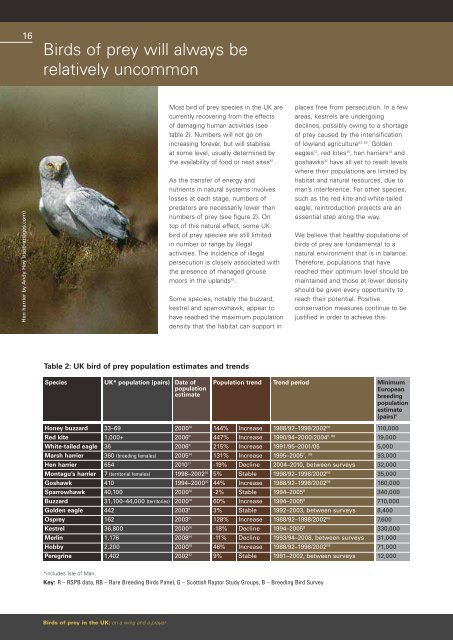BIRDS OF PREY IN THE UK - RSPB
BIRDS OF PREY IN THE UK - RSPB
BIRDS OF PREY IN THE UK - RSPB
Create successful ePaper yourself
Turn your PDF publications into a flip-book with our unique Google optimized e-Paper software.
16<br />
Birds of prey will always be<br />
relatively uncommon<br />
Hen harrier by Andy Hay (rspb-images.com)<br />
Most bird of prey species in the <strong>UK</strong> are<br />
currently recovering from the effects<br />
of damaging human activities (see<br />
table 2). Numbers will not go on<br />
increasing forever, but will stabilise<br />
at some level, usually determined by<br />
the availability of food or nest sites 61 .<br />
As the transfer of energy and<br />
nutrients in natural systems involves<br />
losses at each stage, numbers of<br />
predators are necessarily lower than<br />
numbers of prey (see figure 2). On<br />
top of this natural effect, some <strong>UK</strong><br />
bird of prey species are still limited<br />
in number or range by illegal<br />
activities. The incidence of illegal<br />
persecution is closely associated with<br />
the presence of managed grouse<br />
moors in the uplands 62 .<br />
Some species, notably the buzzard,<br />
kestrel and sparrowhawk, appear to<br />
have reached the maximum population<br />
density that the habitat can support in<br />
places free from persecution. In a few<br />
areas, kestrels are undergoing<br />
declines, possibly owing to a shortage<br />
of prey caused by the intensification<br />
of lowland agriculture 63, 64 . Golden<br />
eagles 12 , red kites 45 , hen harriers 23 and<br />
goshawks 32 have all yet to reach levels<br />
where their populations are limited by<br />
habitat and natural resources, due to<br />
man’s interference. For other species,<br />
such as the red kite and white-tailed<br />
eagle, reintroduction projects are an<br />
essential step along the way.<br />
We believe that healthy populations of<br />
birds of prey are fundamental to a<br />
natural environment that is in balance.<br />
Therefore, populations that have<br />
reached their optimum level should be<br />
maintained and those at lower density<br />
should be given every opportunity to<br />
reach their potential. Positive<br />
conservation measures continue to be<br />
justified in order to achieve this.<br />
Table 2: <strong>UK</strong> bird of prey population estimates and trends<br />
Species<br />
<strong>UK</strong>* population (pairs)<br />
Date of<br />
population<br />
estimate<br />
Population trend<br />
Trend period<br />
Minimum<br />
European<br />
breeding<br />
population<br />
estimate<br />
(pairs) 4<br />
Honey buzzard<br />
Red kite<br />
White-tailed eagle<br />
Marsh harrier<br />
Hen harrier<br />
Montagu’s harrier<br />
Goshawk<br />
Sparrowhawk<br />
Buzzard<br />
Golden eagle<br />
Osprey<br />
Kestrel<br />
Merlin<br />
Hobby<br />
Peregrine<br />
33–69<br />
1,000+<br />
36<br />
360 (breeding females)<br />
654<br />
7 (territorial females)<br />
410<br />
40,100<br />
31,100–44,000 (territories)<br />
442<br />
162<br />
36,800<br />
1,176<br />
2,200<br />
1,402<br />
2000 30 144%<br />
2006 R 447%<br />
2006 R 215%<br />
2005 34 131%<br />
2010 17 -19%<br />
1998–2002 30 5%<br />
1994–2000 30 44%<br />
2000 30 -2%<br />
2000 30 60%<br />
2003 8 3%<br />
2003 G 128%<br />
2000 30 -18%<br />
2008 54 -11%<br />
2000 58 46%<br />
2002 42 9%<br />
Increase<br />
Increase<br />
Increase<br />
Increase<br />
Decline<br />
Stable<br />
Increase<br />
Stable<br />
Increase<br />
Stable<br />
Increase<br />
Decline<br />
Decline<br />
Increase<br />
Stable<br />
1988/92–1998/2002 RB<br />
R, RB<br />
1990/94–2000/2004<br />
1991/95–2001/05<br />
1995–2005 7 , RB<br />
2004–2010, between surveys<br />
1998/92–1998/2002 RB<br />
1988/92–1998/2002 RB<br />
1994–2005 B<br />
1994–2005 B<br />
1992–2003, between surveys<br />
1988/92–1998/2002 RB<br />
1994–2005 B<br />
1993/94–2008, between surveys<br />
1988/92–1998/2002 RB<br />
1991–2002, , between surveys<br />
110,000<br />
19,000<br />
5,000<br />
93,000<br />
32,000<br />
35,000<br />
160,000<br />
340,000<br />
710,000<br />
8,400<br />
7,600<br />
330,000<br />
31,000<br />
71,000<br />
12,000<br />
*includes Isle of Man.<br />
Key: R – <strong>RSPB</strong> data, RB – Rare Breeding Birds Panel, G – Scottish Raptor Study Groups, B – Breeding Bird Survey<br />
Birds of prey in the <strong>UK</strong>: on a wing and a prayer

















